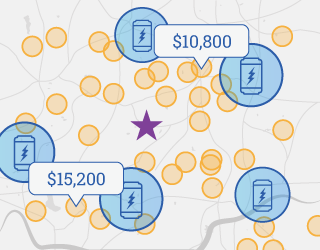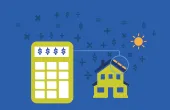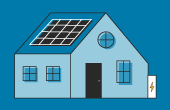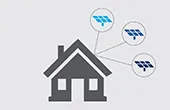The electricity grid is designed to provide reliable electricity service to all homes and businesses at all times of year. To ensure that whenever you flip a switch in your home that the electricity turns on, the grid has to both produce enough electrons to match the electricity that everyone is using throughout the course of the year as well as enough to power everything that’s turned on at the same time. That second ability–making sure there’s enough power to go around at the times when it’s most needed–is peak demand.
Key takeaways
- Electricity consists of both demand (measured in watts) and consumption (measured in watt-hours)
- Peak demand represents the moment when demand is highest on the grid as a whole
- Keeping power plants around to provide capacity during only a few peak hours of the year is pricey, and utilities are beginning to charge for demand in addition to consumption
- You can reduce your own peak demand and, as a result, lower your electricity bills by installing a solar and storage system through EnergySage.
What is peak demand?
Energy requirements are split into usage (or consumption) and demand. While usage focuses on how many kilowatt-hours (kWh) of electricity you use over a certain period of time, demand focuses on how much power a certain appliance or process requires at any given moment. Power requirements will vary from moment to moment for different appliances (i.e., is your refrigerator making ice or just keeping things cold?), meaning power demand will necessarily fluctuate over the course of each day and throughout the year to the grid as a whole.
Peak demand is the amount of capacity required during the single moment when the grid as a whole experiences the highest demand for power. Typically, peak demand occurs on hot summer weekdays in the late afternoon, especially a couple of days into a heat wave: that’s when everyone is at work and air conditioning units are working their hardest to keep everyone cool during the heat of the day.
Why is peak demand important?
Understanding peak demand is an important tool for utilities and grid operators. They need to know how many power plants to have available at any given time on any given day to keep the grid up and running. Utilities and grid operators forecast demand for every moment of every day and are very accurate at parsing weather forecasts to understand grid conditions for the next day to understand how much power will be required, when that day’s peak demand will occur, and how many power plants they’ll need to call to provide electricity during the day. At the same time, utilities and grid operators also forecast peak demand over the next ten years to try to plan for future power needs and get started building power plants to meet that future need today.
But peak demand is important as more than just a planning tool–it’s a useful window into the way that the electricity grid works and the way that we pay for electricity, and also presents an opportunity for achieving significant, and quick, cost savings on the electric grid.
Because electricity is the only commodity that is produced at the exact same time that it is consumed (as Peter Kelly Detwiler points out in The Energy Switch), historically, grid operators have been required to keep around certain power plants that are only run during peak times, maybe for less than 40 hours per year. Because they run so infrequently, these power plants tend to be very inefficient and very expensive to operate from both a cost and environmental impact perspective.
As a result, by reducing peak demand, we can reduce the need for–and costs associated with–these peaking power plants, generating electricity bill savings and reducing emissions at the same time.
How peak demand shows up on your bill
Until very recently, most utility customers–whether home or business owners–paid for electricity based on the amount they consumed over the course of the month, and were charged a flat fee for every kWh of electricity they used. But, as discussed above, two kWh of electricity aren’t necessarily created equal: a kWh of electricity produced at 3 pm on the hottest day of the summer is much costlier than the same kWh produced at 6 am on a weekend in April.
To better reflect this difference in the cost of producing electricity, utilities have introduced new types of electricity rates that account for the different costs associated with producing electricity. Many of these rates are time-varying rates, meaning you’ll pay a different amount per kWh of electricity you consume based on when during the day, week and year you use that kWh.
But some utilities have also introduced demand charges on their rates for primarily industrial electricity users, where you are charged both per kWh as well as per kilowatt (kW) of demand per month. These rates are based on your single moment of highest demand over the course of the month, so you’ll be charged the same amount regardless of how often you hit your peak demand–whether it’s for five minutes or for five hours per day.
How does peak demand impact you?
As the peak demand of the electrical system continues to increase, so too do the costs associated with keeping the grid running reliably on the days of highest power demand. And whether or not your electricity rate includes a demand charge, you can reduce your peak demand and save on your electricity bill by installing solar or solar plus storage. Here’s how:
The impact of solar on peak demand
Peak demand typically occurs during the heat of the day in summer months, which are the exact same times when solar panels are producing the most electricity. As a result, solar can help offset your pull from the grid during those peak hours, lowering the overall need for power and reducing your individual peak demand. In fact, when aggregated across all of the distributed solar panel systems on the grid, this impact is significant: check out our guest post from Synapse Energy Economics to learn just how significant of a cost saver distributed solar is.
The impact of batteries on peak demand
Batteries can also contribute to lowering your peak demand in two ways. First, if your peak usage happens after the sun sets, you can store solar energy during the day in your battery and then pull from your battery during the evening instead of from the grid, reducing your peak demand from your utility. Second, if you have appliances or processes that require a significant amount of power for small amounts of time (perhaps startup power of an HVAC for instance), an appropriately sized battery can reduce the stress that places on the grid, leading to significant savings if you have demand charges on your bill.
Lower your peak demand with solar and storage
Solar and storage can reduce your electricity bills in many different ways, including by reducing your demand for power from the grid. The best way to see how much solar and storage can save you is to compare multiple real quotes from local solar companies. That’s exactly where EnergySage helps: when you sign up for a free account on EnergySage, we’ll gather multiple solar (and storage!) quotes from companies in your area for you to compare all from the comfort of your couch.

More reading on EnergySage
Off-Peak Electricity Hours: Cheapest Time to Use Electricity
What’s On Your Company’s Electric Bill?
Should Your Business Invest In Energy Storage?
Best Solar Batteries Reviewed: Tesla, sonnen, and More
What Are Time of Use (TOU) Rates? How Do They Work?





